On the Wrecks
by wjw on November 19, 2016
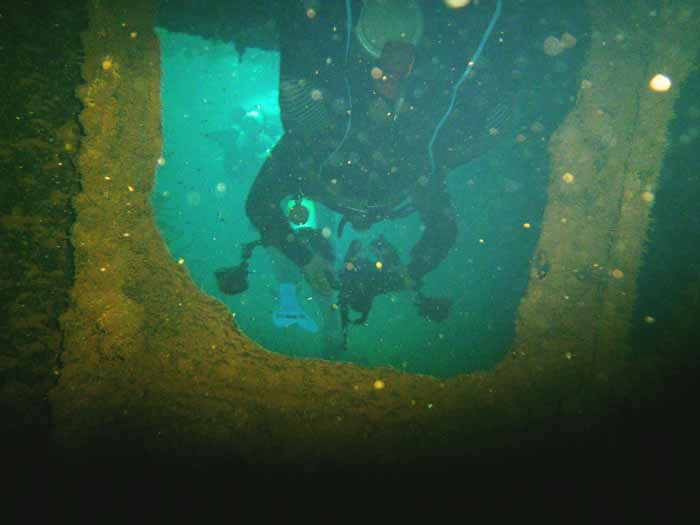 During my week in Palau I did 25 dives, but after we shifted to Chuuk I did eight dives over the course of five days, all of them on Japanese wrecks from the Second World War. I was more than ready for the more leisurely pace. Doing five dives per day is work.
During my week in Palau I did 25 dives, but after we shifted to Chuuk I did eight dives over the course of five days, all of them on Japanese wrecks from the Second World War. I was more than ready for the more leisurely pace. Doing five dives per day is work.
Instead of living on a dive boat, we were based on a resort on shore. It took some time for me to lose my sea legs, and every so often the resort would seem to swoop up to the crest of a wave, then slide back down again.
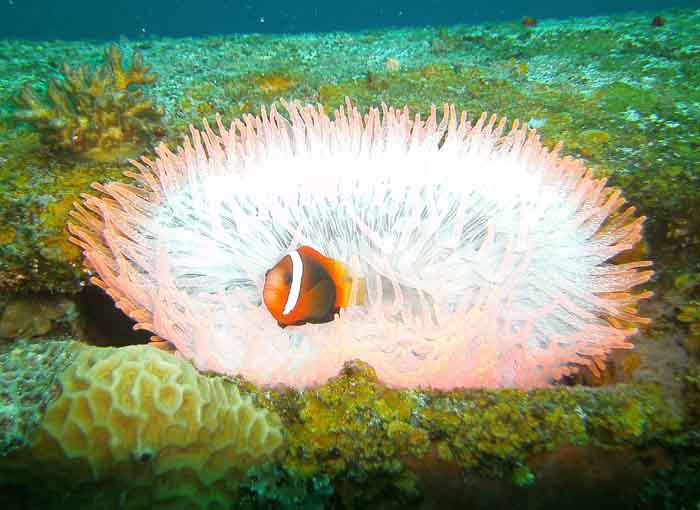 We were also rather more obviously in the Third World. (The term is not a criticism, but a description.) On Palau Aggressor we were in a little bubble of the developed world filled with modern technology, abundant mostly-American cuisine, and experienced staff who solved almost all our technical problems. In Chuuk we were more on our own, a fact that became obvious on my very first dive.
We were also rather more obviously in the Third World. (The term is not a criticism, but a description.) On Palau Aggressor we were in a little bubble of the developed world filled with modern technology, abundant mostly-American cuisine, and experienced staff who solved almost all our technical problems. In Chuuk we were more on our own, a fact that became obvious on my very first dive.
Our dive gear (which we owned) had been mated with air cylinders (owned by the dive company) on shore, then bundled into a skiff for transportation to the dive site. I was uncertain that mine had actually got on the right boat and went to the back to sort through the pile of gear, which was lucky, because I discovered that rough handling had pulled one of my BC inflator hoses from the power inflator.
(The BC, or buoyancy compensator, is the Mae West-type jacket worn by divers to adjust their buoyancy during the dive. The power inflator adds air to the BC from the diver’s air supply, and also holds a dump valve for release of air when necessary. The BC also holds the air cylinder in place, and in my particular case also holds the lead weights necessary to get me beneath the surface.)
The hose is normally held in place with a cable tie, but there was no cable tie on the boat, so we returned to shore. A cable tie was procured, and our guide made the repair. It was clear to even the most detached observer that the repair was inadequate, and the hose was still partly detached. I called in Stacey to consult, and we returned to shore a second time for cable ties from Stacey’s repair kit, which she’d left on shore. Stacey made the repair, and put on a second cable tie for good measure.
Back in the First World of the Aggressor, the skiffs were equipped with kits enabling common repairs, and almost certainly would have had cable ties, O-rings (losing an O-ring is very common), some tools, some Band Aids, and so on. We had able and helpful guides. Now in the Third World, we were on our own.
This was a useful reminder, and I was glad I got it on the very first dive. Ultimately a diver is responsible for his own gear, and from that point I made a point of being a bit anal about my equipment. On my next dive I had a packet of cable ties in my pocket. I thought I had a bag of O-rings somewhere, but I couldn’t find it, and so if an O-ring blew I was out of luck, unless one of my fellow divers had a spare. But still I was as prepared as I could be, and made a point of checking out my gear throughly before it was loaded on the skiff.
 Chuuk, probably more familiar under its previous name of Truk, is the most populated of the Federated States of Micronesia. During the Second World War, Truk Lagoon was the largest base of the Imperial Japanese Navy, holding two fleets, support and supply vessels, five airfields, a seaplane base, and over 40,000 soldiers and sailors. The naval contingent included the two largest battleships ever built, Yamato and Musashi. (72,800 tons vs. 45,000 tons for the American Iowa class.) These mega-craft, awesome though they and their 18-inch guns were, hardly ever shifted from their anchorages, because they required so much fuel that it was too costly to move them.
Chuuk, probably more familiar under its previous name of Truk, is the most populated of the Federated States of Micronesia. During the Second World War, Truk Lagoon was the largest base of the Imperial Japanese Navy, holding two fleets, support and supply vessels, five airfields, a seaplane base, and over 40,000 soldiers and sailors. The naval contingent included the two largest battleships ever built, Yamato and Musashi. (72,800 tons vs. 45,000 tons for the American Iowa class.) These mega-craft, awesome though they and their 18-inch guns were, hardly ever shifted from their anchorages, because they required so much fuel that it was too costly to move them.
By the beginning of 1944 American successes elsewhere in the Pacific made Truk vulnerable to attack, and so the Japanese evacuated almost all the warships, just ahead of Operation Hailstone in January 1944. American bombers and carrier-based planes hammered the islands for three days, sinking over a dozen of the small warships that remained, along with 32 merchant ships, plus destroying 270 aircraft at the cost of 25 American planes. The ships caught in the raid were either supplying the garrison, or lacked the fuel to get away.
Truk was raided by a Royal Navy task force toward the end of the war, apparently just for practice, but otherwise the islands were left alone till the Japanese surrender. The thousands of soldiers prepared to defend the islands to the last spent the latter part of the war tending their taro and coconut plantations, and after the surrender the half-starved remnants were shipped home, much luckier than their comrades on Saipan, Iwo Jima, and elsewhere.
We dived seven shipwrecks, plus some aircraft wrecks including the Betty mentioned in an earlier post, and an enormous Kawanishi flying boat, known to the allies as the “Emily.” (The Emily took part in the second raid on Pearl Harbor, which I bet you never knew about.) Most of the wrecks sank on an even keel, or have a slight list, but some lie on their sides. Some gaping holes in the hull indicate where torpedoes or bombs hit, and some parts of the ships are missing completely— the aft part of the Sankisan Maru has disintegrated, and the pilot house collapsed, presumably a result of an explosion hitting the munitions stored in the hold.
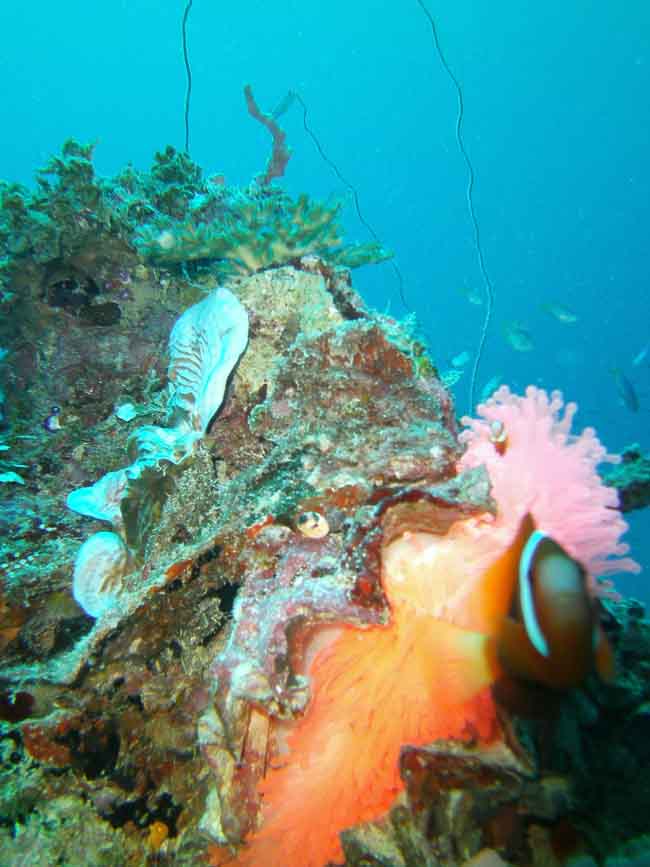 For the most part the wrecks lie on sand, which— beyond clumps of coral here and there— is not exactly teeming with life. But the wrecks are brilliant with life, corals and anemone and tens of thousands of fish of all sizes.
For the most part the wrecks lie on sand, which— beyond clumps of coral here and there— is not exactly teeming with life. But the wrecks are brilliant with life, corals and anemone and tens of thousands of fish of all sizes.
There are safe paths through the wrecks, known to the guides, and though penetrating into the engine room or cruising through the superstructure is not exactly the safest diving I’ve done— no one has gone through the wrecks to remove the sharp bits— I also wasn’t going anywhere that hundreds of people hadn’t gone before.
There were a couple places I decided not to go, after the entrances proved too small, or repeatedly tried to grab my gear. I’m a big guy, and I require a fair amount of room. Other people had no problem.
Deck guns are still emplaced, even on decks tilted at 90 degrees. The china remains in the dining room, the stoves loom in the galley, toilets are emplaced in the crew quarters, and the engine telegraph still stands on the foredeck. One of the propellers of the Rio de Janeiro Maru stands clear of the sand. Considering that these ships met violent deaths, it’s amazing how much has survived intact. In the enormous Shinkoku Maru, a tanker also used as a hospital, there’s still a surgical table in the operating room, along with bottles for oxygen and anesthetic.
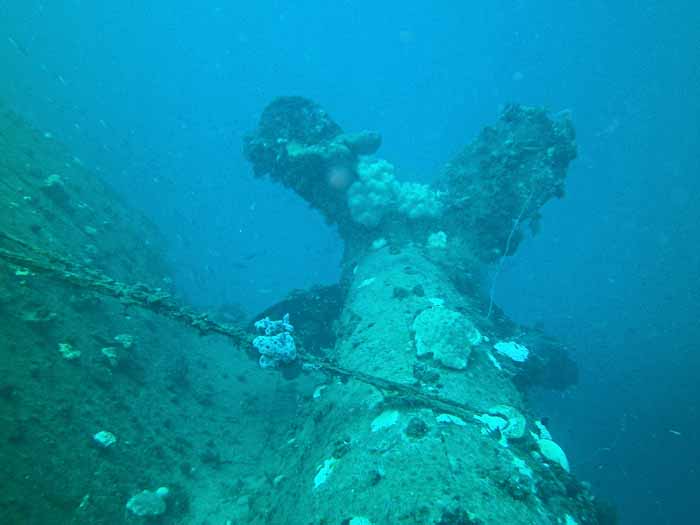 Many of the holds are still full, and give the impression that the Japanese armed forces ran on two things: munitions and sake. There are thousands of sake bottles still intact, some still in cases racked in the hold. I saw airplane engines, medicine bottles, bullets, bombs, grenades, propellers, trucks and jeeps, aircraft parts, torpedoes, 18-inch shells waiting for Yamato (or Captain Harlock), big gun mounts and a big cannon. In the Kensho Maru, which lies on its side, I made my way into the engine room and saw enormous boilers, condensers, cylinder heads, and other relics of the steam age all tilted on their sides but still recognizable. I can see where cruising through a ship lying on its side might be disorienting, but I was not disoriented.
Many of the holds are still full, and give the impression that the Japanese armed forces ran on two things: munitions and sake. There are thousands of sake bottles still intact, some still in cases racked in the hold. I saw airplane engines, medicine bottles, bullets, bombs, grenades, propellers, trucks and jeeps, aircraft parts, torpedoes, 18-inch shells waiting for Yamato (or Captain Harlock), big gun mounts and a big cannon. In the Kensho Maru, which lies on its side, I made my way into the engine room and saw enormous boilers, condensers, cylinder heads, and other relics of the steam age all tilted on their sides but still recognizable. I can see where cruising through a ship lying on its side might be disorienting, but I was not disoriented.
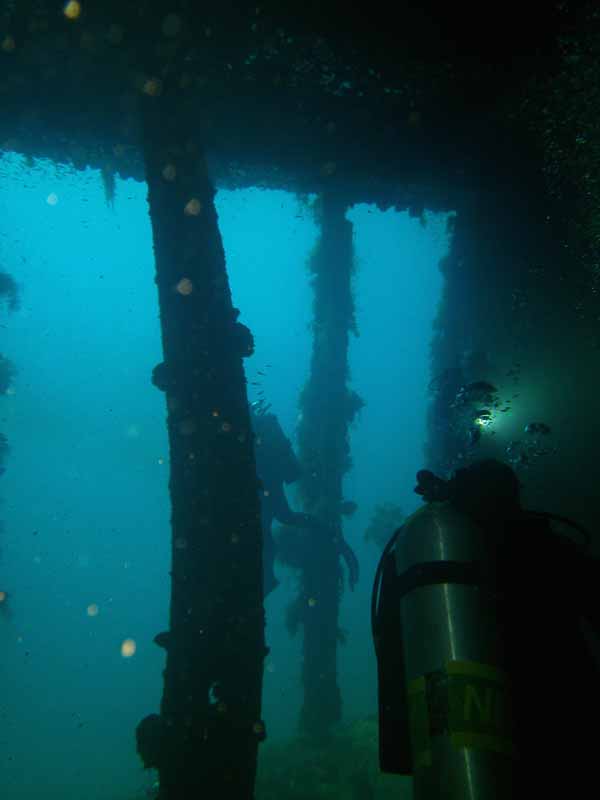 For those of you inclined to the ghoulish, I should remark that I saw no human remains. These are returned to Japan, I believe, though sometimes they lie around for awhile waiting for a credentialed Japanese archaeologist to come out and retrieve them.
For those of you inclined to the ghoulish, I should remark that I saw no human remains. These are returned to Japan, I believe, though sometimes they lie around for awhile waiting for a credentialed Japanese archaeologist to come out and retrieve them.
Visibility outside the ships was generally very good, and inside depended on how much muck was kicked up by the divers. There was never so much turbidity that we couldn’t see. Currents were minimal, and the water was 88 degrees, which meant I didn’t need a wet suit. Outside the ships the fish were everywhere, mostly swarms of small fish that covered the ships like clouds. Larger predator fish hovered around, and some turtles, though to my surprise I saw very few sharks.
The wrecks were fascinating, pieces of a tragic history now abundant with new life. It was brilliant and unforgettable, though I doubt I will ever feel the need to return. Having experienced it once, I have no particular urge to experience it all again. I’ll be choosing another destination next time.
Stories may well be tickling at my brain. We’ll see.
 During my week in Palau I did 25 dives, but after we shifted to Chuuk I did eight dives over the course of five days, all of them on Japanese wrecks from the Second World War. I was more than ready for the more leisurely pace. Doing five dives per day is work.
During my week in Palau I did 25 dives, but after we shifted to Chuuk I did eight dives over the course of five days, all of them on Japanese wrecks from the Second World War. I was more than ready for the more leisurely pace. Doing five dives per day is work.  We were also rather more obviously in the Third World. (The term is not a criticism, but a description.) On Palau Aggressor we were in a little bubble of the developed world filled with modern technology, abundant mostly-American cuisine, and experienced staff who solved almost all our technical problems. In Chuuk we were more on our own, a fact that became obvious on my very first dive.
We were also rather more obviously in the Third World. (The term is not a criticism, but a description.) On Palau Aggressor we were in a little bubble of the developed world filled with modern technology, abundant mostly-American cuisine, and experienced staff who solved almost all our technical problems. In Chuuk we were more on our own, a fact that became obvious on my very first dive. Chuuk, probably more familiar under its previous name of Truk, is the most populated of the Federated States of Micronesia. During the Second World War, Truk Lagoon was the largest base of the Imperial Japanese Navy, holding two fleets, support and supply vessels, five airfields, a seaplane base, and over 40,000 soldiers and sailors. The naval contingent included the two largest battleships ever built, Yamato and Musashi. (72,800 tons vs. 45,000 tons for the American Iowa class.) These mega-craft, awesome though they and their 18-inch guns were, hardly ever shifted from their anchorages, because they required so much fuel that it was too costly to move them.
Chuuk, probably more familiar under its previous name of Truk, is the most populated of the Federated States of Micronesia. During the Second World War, Truk Lagoon was the largest base of the Imperial Japanese Navy, holding two fleets, support and supply vessels, five airfields, a seaplane base, and over 40,000 soldiers and sailors. The naval contingent included the two largest battleships ever built, Yamato and Musashi. (72,800 tons vs. 45,000 tons for the American Iowa class.) These mega-craft, awesome though they and their 18-inch guns were, hardly ever shifted from their anchorages, because they required so much fuel that it was too costly to move them. For the most part the wrecks lie on sand, which— beyond clumps of coral here and there— is not exactly teeming with life. But the wrecks are brilliant with life, corals and anemone and tens of thousands of fish of all sizes.
For the most part the wrecks lie on sand, which— beyond clumps of coral here and there— is not exactly teeming with life. But the wrecks are brilliant with life, corals and anemone and tens of thousands of fish of all sizes. Many of the holds are still full, and give the impression that the Japanese armed forces ran on two things: munitions and sake. There are thousands of sake bottles still intact, some still in cases racked in the hold. I saw airplane engines, medicine bottles, bullets, bombs, grenades, propellers, trucks and jeeps, aircraft parts, torpedoes, 18-inch shells waiting for Yamato (or Captain Harlock), big gun mounts and a big cannon. In the Kensho Maru, which lies on its side, I made my way into the engine room and saw enormous boilers, condensers, cylinder heads, and other relics of the steam age all tilted on their sides but still recognizable. I can see where cruising through a ship lying on its side might be disorienting, but I was not disoriented.
Many of the holds are still full, and give the impression that the Japanese armed forces ran on two things: munitions and sake. There are thousands of sake bottles still intact, some still in cases racked in the hold. I saw airplane engines, medicine bottles, bullets, bombs, grenades, propellers, trucks and jeeps, aircraft parts, torpedoes, 18-inch shells waiting for Yamato (or Captain Harlock), big gun mounts and a big cannon. In the Kensho Maru, which lies on its side, I made my way into the engine room and saw enormous boilers, condensers, cylinder heads, and other relics of the steam age all tilted on their sides but still recognizable. I can see where cruising through a ship lying on its side might be disorienting, but I was not disoriented. For those of you inclined to the ghoulish, I should remark that I saw no human remains. These are returned to Japan, I believe, though sometimes they lie around for awhile waiting for a credentialed Japanese archaeologist to come out and retrieve them.
For those of you inclined to the ghoulish, I should remark that I saw no human remains. These are returned to Japan, I believe, though sometimes they lie around for awhile waiting for a credentialed Japanese archaeologist to come out and retrieve them.
An odd irony of history that here the destruction unleashed by total war resulted in a flourishing ecosystem where there had only been barren sand before.
Fascinating and beautiful images. Thanks for sharing!
Comments on this entry are closed.